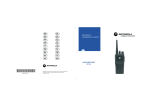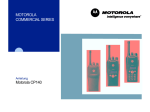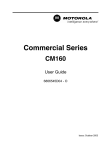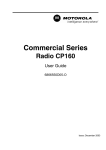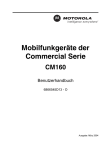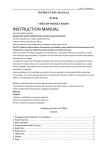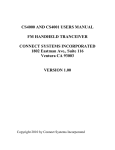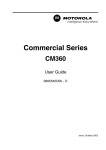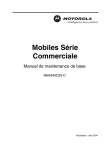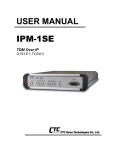Download Motorola CM140 User guide
Transcript
User Guide Covers CM140/160
10/06/03
08:32
Page 1
MOTOROLA
COMMERCIAL SERIES
BASIC USER GUIDE
CM140 & CM160
6866545D01-O
MOTOROLA and the Stylized M Logo are registered in the U.S. Patent & Trademark Office.
All other product or service names are the property of their respective owners.
© Motorola, Inc. 2003.
CM160_InsdeCov.fm Page 1 Monday, November 24, 2003 3:59 PM
11
4
2
1
10
CHAN 34
11
P1
P2
P3
P4
8
3
5
English
7
6
10
9
CM140_160_EN.fm Page 1 Monday, November 24, 2003 3:49 PM
This user guide covers the operation of the CM160
and CM140 Mobile Radios.
Contents
Radio Overview . . . . . . . . . . . . . . . . . . . . 2
Radio Controls . . . . . . . . . . . . . . . . . . . . . .
Microphone Controls . . . . . . . . . . . . . . . . .
Audio Signal Tones . . . . . . . . . . . . . . . . . .
Programmable Buttons . . . . . . . . . . . . . . .
Menu Buttons (CM160) . . . . . . . . . . . . . . .
Menu Navigation Chart (CM160) . . . . . . . .
LCD Display and Icons (CM160) . . . . . . . .
2
2
3
3
4
5
6
Getting Started . . . . . . . . . . . . . . . . . . . . . 7
Turning the Radio On-Off. . . . . . . . . . . . . . 7
Adjusting the Volume . . . . . . . . . . . . . . . . . 7
Radio On Message (CM160) . . . . . . . . . . . 7
Radio On Indicator (CM140) . . . . . . . . . . . 8
Selecting a Radio Channel. . . . . . . . . . . . . 8
Receiving a Call . . . . . . . . . . . . . . . . . . . . . 9
Sending a Call . . . . . . . . . . . . . . . . . . . . . . 9
Making a Selective Call . . . . . . . . . . . . . . 10
Cancelling a Call . . . . . . . . . . . . . . . . . . . 10
Ending a Call . . . . . . . . . . . . . . . . . . . . . . 10
Before using this product, read the
operating instructions for safe usage
contained in the Product Safety and
RF Exposure booklet 6866537D37_
C a u t i o n enclosed with your radio.
!
ATTENTION!
This radio is restricted to occupational use only to
satisfy ICNIRP RF energy exposure requirements.
Before using this product, read the RF energy
awareness information and operating instructions in
the Product Safety and RF Exposure booklet
(Motorola Publication part number 6866537D37_) to
ensure compliance with RF energy exposure limits.
Computer Software Copyright
The products described in this manual may include copyrighted computer
programmes stored in semiconductor memories or other media. Laws in
the United States of America and other countries preserve for Motorola
Europe and Motorola Inc. certain exclusive rights for copyrighted computer
programmes, including the right to copy or reproduce in any form the
copyrighted computer programme. Accordingly, any copyrighted computer
programmes contained in the products described in this manual may not
be copied or reproduced in any manner without the express written
permission of the holders of the rights. Furthermore, the purchase of these
products shall not be deemed to grant either directly or by implication,
estoppel, or otherwise, any licence under the copyrights, patents, or patent
applications of the holders of the rights, except for the normal nonexclusive royalty free licence to use that arises by operation of the law in
the sale of the product.
1
English
BASIC USER GUIDE
SAFETY INFORMATION
BASIC USER GUIDE
CM140_160_EN.fm Page 2 Monday, November 24, 2003 3:49 PM
RADIO OVERVIEW
Radio Controls
BASIC USER GUIDE
The numbers below refer to the illustrations on the
inside front and rear covers.
1. On-Off / Volume Knob
Used to turn the radio on or off, and to adjust the
radio’s volume.
2. LED Indicators
Indicate radio status:
Green: Solid during power up routine; off after
successful power up; flashing when scanning.
Red: Solid when transmitting: flashing channel is busy receiving.
Yellow: Solid when radio is in monitor mode,or
is sending a selective call or call alert;
Flashing - receiving a selective call or call alert.
3. Mic Jack
CM160 Radios
4. LCD Display
An 8 character single line display with up to 9
radio status icons.
5. Navigation up or down
Used for channel scrolling, menu
navigation and scrolling menu lists.
6. Menu Buttons C D
D used to access the menu and select the
menu options, C to exit menu.
English
2
7. Programmable Buttons C D E F
Dual function buttons. Short press selects
function 1; long press selects function 2.
CM140 Radios
4. LCD Display
A single digit (0 to 9) display, shows the Channel
number. The display also shows a dot to indicate
High power selected.
5. Up/Down key
Used for channel scrolling.
6. Programmable Button 1 C
7. Programmable Button 2 D
Microphone Controls
(Keypad Microphone)
Hold the microphone 2.5 to 5 cm (1-2 inches) from
your mouth, and speak clearly into it.
8. Keypad
9.
Programmable Keys { } |
10. Push-to-talk (PTT)
Press and hold down this button to talk;
release it to listen.
11. Microphone
Audio Signal Tones
Programmable Buttons
High pitched tone
Several of your radios keys and buttons can be
programmed, by Customer Programming Software
(CPS), as short-cut buttons for many of the radio’s
features. Programmable buttons include:
Signal
Low pitched tone
Description
Self Test Pass Tone.
Self Test Fail Tone.
Positive Indicator Tone.
Negative Indicator Tone.
CM160 C D E F
CM140 C D
Keypad microphone { } |
Each button is dual function; a short press may
select one function, a long press may select the
second.
Check with your dealer for a complete list of the
functions your radio supports.
Good key press.
Bad key press.
3
English
BASIC USER GUIDE
CM140_160_EN.fm Page 3 Monday, November 24, 2003 3:49 PM
CM140_160_EN.fm Page 4 Monday, November 24, 2003 3:49 PM
Menu Buttons (CM160)
Menu Select Button D
BASIC USER GUIDE
The D button is dedicated to Menu access and
menu option selections.
Menu Exit Button C
In Menu Mode, this button is automatically assigned
to exit the menu. A long press exits the menu
immediately, while short presses are used to move
up to the next higher Menu level. When the top level
menu is selected, a short press will exit the Menu
Mode.
The radio also exits the Menu Mode after an
“Inactivity Time” timeout
Once the menu mode is exited, both C and D
buttons return to their normal programmable
condition.
English
4
Up /Down Navigation Keys G/H
Used to navigate when in Menu Mode.
Increment/decrement channel number or scroll
through menu list options. If you scroll past the last
option the selection wraps around and starts again.
On reaching the required option, a short press of
D selects the option.
Refer to the menu navigation chart for menu
selectable features.
CM140_160_EN.fm Page 5 Monday, November 24, 2003 3:49 PM
(Refer to Menu Navigation guidelines—
lower, left-hand corner of this page)
Radio
Calls
Repeater/
Talkround
System
Scan
Reptr mode /
Talkrnd mode
On/Off
D
Program
Lists
Phone
Alert
On/Off
Selective
Call
Call Alert
Phone List
Select/enter
ID
Select/enter
ID
add/
delete/
edit entry
D to enter Menu Mode.
Normal/Tight
Keypad
On/Off
On/Off
Backlight
Tone Tag
Menu Navigation Guidelines
Squelch
Power Level
Scan List
add/
delete entry
Set prority
Utilities
Tones
Standard/alert
1-6
Hi/Med/Lo
Option Bd
On/Off
Escalert
or
to scroll through the list.
D to select Menu item
C return to previous menu level or
Hold down C to exit Menu Mode
On/Off
or
Software Ver
to scroll through the
Menu sub-list.
D to select sum-menu item.
5
English
BASIC USER GUIDE
MENU NAVIGATION CHART (CM160)
CM140_160_EN.fm Page 6 Monday, November 24, 2003 3:49 PM
LCD DISPLAY AND ICONS (CM160)
Symbol
BASIC USER GUIDE
Scan Indicator
Indicates that the scan feature is
activated.
CHAN 34
Priority Scan Indicator
Indicates that the scan feature is
activated. The dot is flashing during
priority scan mode when scan has
landed on a Priority 1 channel.
The dot is steady during priority scan
mode when scan has landed on a
Priority 2 channel.
Displays radio Status, Addresses or Channel, on
one line of 8 characters. The top line of the display
shows radio status icons, explained in the table
below:
Symbol
Name and Description
Option Board Indicator
Indicates that an option board is
activated in the radio.
Phone Indicator
Phone mode is selected.
Call Received Indicator
A Selective Call or Call Alert has been
received.
Signal Strength Indicator
The more bars, the stronger the signal
being received by your radio.
Talkaround Indicator
You are transmitting directly to another
radio, not via a repeater.
Power Level Indicator
“L” lights when your radio is configured
to transmit in Low Power. “H” lights
when your radio is configured to
transmit in High Power.
Monitor Indicator
The selected channel is being
monitored.
English
6
Name and Description
Emergency Indicator
An Emergency Alarm is being sent.
Note:
At extremely low temperatures, you may
experience a slight delay in displaying new
information. This is normal and does not affect the
function of your radio.
GETTING STARTED
Adjusting the Volume
Turning the Radio On/Off
Turn the On/Off/Volume Control knob clockwise to
increase the volume, or counterclockwise to
decrease the volume.
– or– use the pre-programmed Volume Set button:
Volume Control Knob
ON
OFF
1
Hold down the Volume Set button. You will
hear a continuous tone.
2
Turn the On/Off/Volume Control knob to the
desired volume level.
3
Release the Volume Set button.
Radio On Message (CM160)
ON
OFF
Rotate the On/Off/
Volume Control knob
clockwise until you
hear a click.
Rotate the On/Off/
Volume Control knob
counterclockwise until
you hear a click. The
display clears and the
LED indicators turn off .
At power up the radio may display a message
customised by your dealer, e.g.:
RADIO ON
After this text has been displayed, the radio
performs a self test routine. During the routine the
Green LED lights. On completion of a successful
self test the radio produces the Self-Test pass Tone,
the Green LED indicator goes out and the display
shows the channel that was in use at power down,
typically:
CHAN 35
This may be a number or an alias and will be the
current channel.
7
English
BASIC USER GUIDE
CM140_160_EN.fm Page 7 Monday, November 24, 2003 3:49 PM
CM140_160_EN.fm Page 8 Monday, November 24, 2003 3:49 PM
BASIC USER GUIDE
Radio On Indication (CM140)
Selecting a Radio Channel
At power up the radio performs a self test routine.
During the routine the Green LED lights. On
completion of a successful self test the radio
produces the Self-Test pass Tone, the Green LED
indicator goes out and the display shows the
Channel that was in use at power down, typically:
Your radio offers up to 64 channels (CM160), or 8
channels (CM140), however some may not be
programmed. Check with your dealer for more
information.
Press G to increment the Channel number
or H to decrement it.
5
If the radio fails the power up routine the power up
fail tone sounds and the error number is displayed.
Note: If your radio fails the self test routine, record
the error number and consult your dealer.
Using Home Revert Memory Channels (1&2)
Two of the programmable buttons may be preprogrammed by your dealer as Memory Channel
buttons, allowing you quick access to frequently
used channels. A press of the button will take you to
the assigned channel.
Using the Microphone Keypad (If programmed)
Enter the desired channel number on the keypad.
Press # on the keypad to select the channel.
English
8
CM140_160_EN.fm Page 9 Monday, November 24, 2003 3:49 PM
Sending a Call
1
Turn your radio on.
1
Turn your radio on.
2
Adjust the radio’s volume.
2
Select the desired channel.
3
Select the desired channel.
3
4
To respond, hold the microphone vertically 2.5
to 5 cm (1 to 2 inches) from your mouth. Press
the PTT to talk; release it to listen
Hold the microphone vertically 2.5 to 5 cm
(1 to 2 inches) from your mouth. Press the
PTT to talk; release it to listen.
Note: The system may have a limited call time and
the call may be terminated automatically if
this call time is exceeded.
If your system uses the request-to-talk feature, use
the following method to send a call:
1
Turn your radio on.
2
Select the desired channel.
3
Press the PTT (for priority requests to talk, the
PRTT button) and wait for the talk permit tone.
4
Hold the microphone vertically 2.5 to 5 cm
(1 to 2 inches) from your mouth. Press the
PTT to talk; release it to listen.
Your radio may be configured for ‘Transmit Inhibit’
under certain conditions (e.g. when the channel is in
use by others) in which case, the channel busy tone
will sound when you press the PTT or call button to
indicate that transmission is inhibited.
9
English
BASIC USER GUIDE
Receiving a Call
CM140_160_EN.fm Page 10 Monday, November 24, 2003 3:49 PM
BASIC USER GUIDE
Making a Selective Call
Cancelling a Call
You can make a selective call to a particular radio,
known as an individual call, or a group of radios,
known as a group call.
You can make calls by using the Menu (CM160),
the pre-programmed Radio Call button or Manual
Dialling (using the keypad microphone).
At any time while setting up a call, it may be cancelled
by pressing the Monitor button, or replacing the
microphone in its holder (referred to as going “on
hook”) .
The call timer can also cancel a call.
Ending a Call
A call should always be ended by pressing the
Monitor button, or replacing the microphone in its
holder.
English
10
CM140_InsdeCov.fm Page 1 Monday, November 24, 2003 3:58 PM
11
2
1
4
8
4.
11
9
8
3
5
10
6
7
EN
SF
DE
GK
FR
RU
ES
CZ
IT
HU
PR
PL
DA
RO
SV
TU
NL
AR
MOTOROLA
COMMERCIAL S ERIES
BASIC USER GUIDE
CM140 & CM160
@6866545D01@
6866545D01-A
MOTOROLA and the Stylized M Logo are registered in the U.S. Patent & Trademark Office.
All other product or service names are the property of their respective owners.
© Motorola, Inc. 2004.














